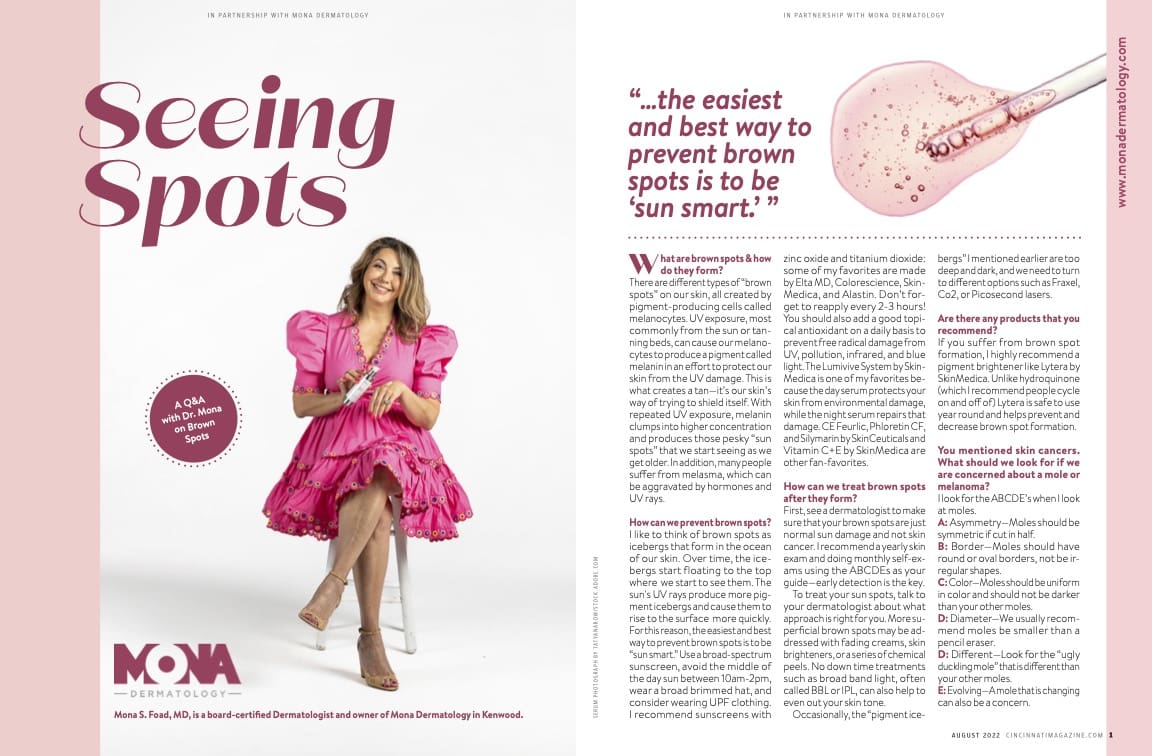Q&A with Dr. Mona on Brown Spots
What are brown spots and how do they form?
There are different types of “brown spots” that might suddenly appear on our skin. Pigment producing cells called melanocytes create them all. UV exposure, most commonly from the sun or tanning beds, can cause our melanocytes to produce a pigment called melanin in an effort to protect our skin from the UV damage. This is what creates a tan. It’s our skin’s way of trying to shield itself. With repeated UV exposure, melanin clumps into higher concentration and produces those pesky “sun spots” that we start seeing as we get older. In addition, many people suffer from melasma, which can be aggravated by UV ray and hormonal causes.

How can we prevent brown spots?
I like to think of brown spots as icebergs that form in the ocean of our skin. Over time, the icebergs start floating to the top where we start to see them. The sun’s UV rays produce more pigment icebergs and cause them to rise to the surface more quickly.
For this reason, the easiest and best way to prevent brown spots suddenly appearing on the skin is to be “sun smart.” Use a broad-spectrum sunscreen. Avoid the middle of the day sun between 10am-2pm. Wear a broad brimmed hat, and consider wearing UPF clothing. I recommend sunscreens with zinc oxide and titanium dioxide. Some of my favorites are made by Elta MD, Colorescience, SkinMedica, and Alastin. Don’t forget to reapply every 2-3 hours!
You should also add a good topical antioxidant on a daily basis to prevent free radical damage from UV, pollution, and blue light. The Lumivive System by Skinmedica is one of my favorites. The day serum protects your skin from environmental damage, while the night serum repairs that damage. CE Ferulic, Phloretin CF and Sillymarin by SkinCeuticals are other fan-favorite antioxidants as well.
How can we treat brown spots after they form?
First, see a dermatologist to make sure that your brown spots are just normal sun damage and not something else such as skin cancer. I recommend a yearly skin exam and doing monthly self-exams using the ABCDEs as your guide. Early detection of skin cancers can result in higher cure rates.
To treat your brown spots, talk to your dermatologist about what approach is right for you. More superficial brown spots may be addressed with fading creams, skin brighteners, or a series of chemical peels. No down time treatments such as broad band light, often called BBL or IPL, can also help to even out your skin tone.
Occasionally, the “pigment icebergs” I mentioned earlier are too deep and dark, and we need to turn to different options such as Fraxel, Co2, or Picosecond lasers to break up the brown spots.
Are there any products that you recommend?
If you suffer from brown spot formation, I highly recommend a pigment brightener like Even & Correct by SkinMedica. Unlike hydroquinone (which I recommend people cycle on and off of) Even & Correct is safe to use year round and helps prevent and decrease brown spot formation.
As seen in Cincinnati Magazine.
